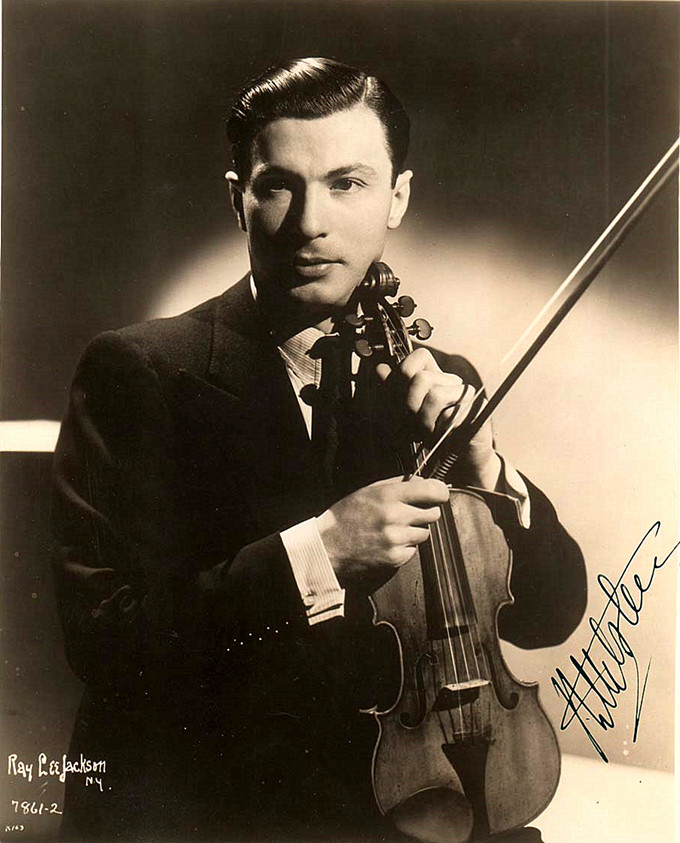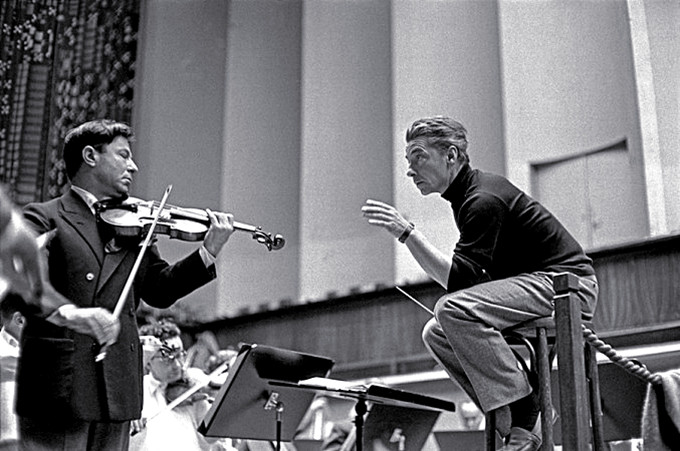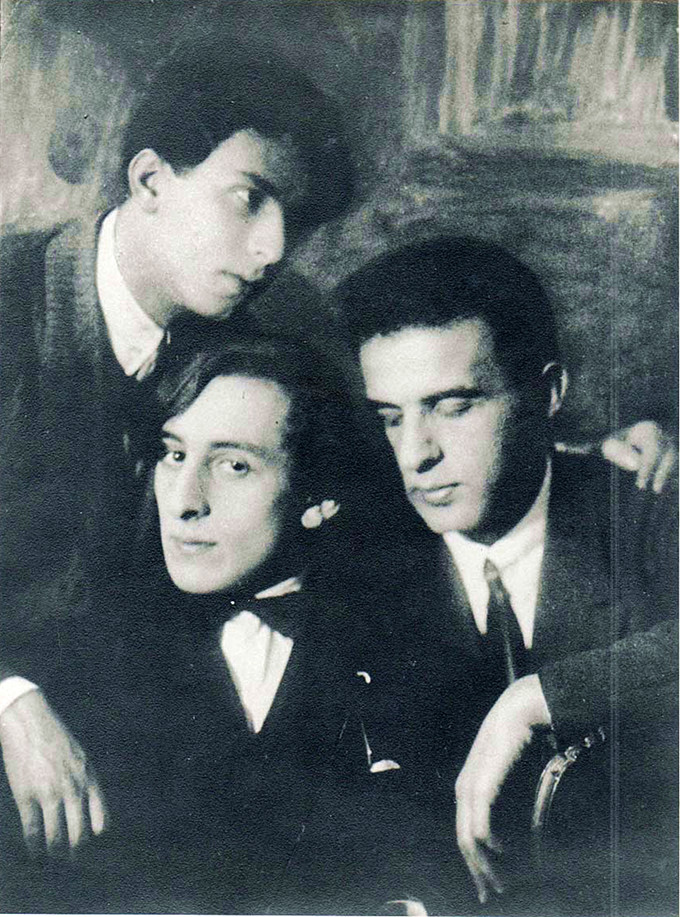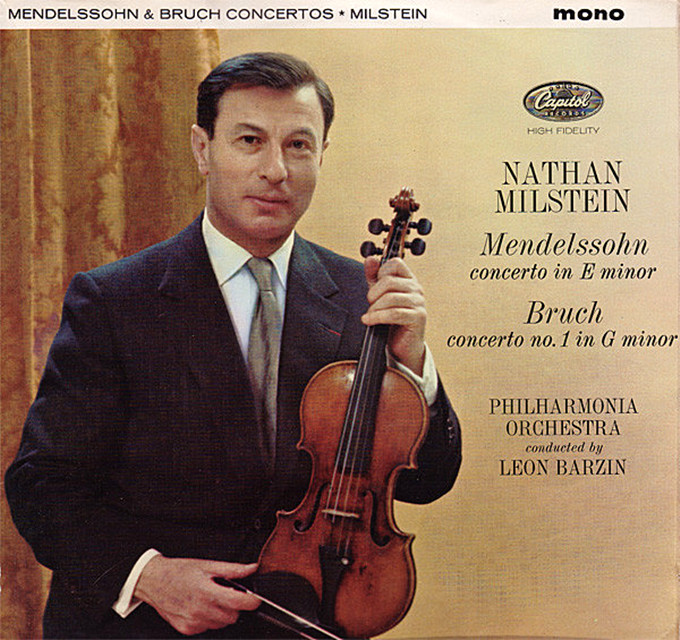| |
| |
莫扎特之旅整理
文/图 2017-03-14 16:26 |
|
| |
|
|
|
|
| |
 |
|
|
|
| |
THE IMMORTALS: Nathan Milstein
|
|
|
|
| |
Julian Haylock explores the life, musicianship and recordings of a
man who for many represented the pinnacle of all a violinist can be |
|
|
|
| |
Nathan Mironovich Milstein was a Ukrainian-born American virtuoso
violinist. Widely considered one of the finest violinists of the 20th
century, Milstein was known for his interpretations of Bach's solo
violin works and for works from the Romantic period. He was also known
for his long career: he performed at a high level into his mid 80s,
retiring only after suffering a broken hand. |
|
|
|
| |
内森·米罗诺维奇·米尔斯坦是乌克兰出生的美国小提琴演奏家。他被广泛认为是第二十世纪最优秀的小提琴家之一,以他对巴赫独奏小提琴作品的诠释和浪漫时期的作品而闻名。他也以其漫长的职业生涯而闻名:他在80年代中期的演奏水平很高,直到他受伤后才退休。 |
|
|
|
| |
Nathan Milstein was a violinist’s violinist. Purity was his watchword as
he negotiated even the most notorious technical chicanery with a
nonchalant sleight-of-hand. He avoided the use of shoulder pads or rests
as they impeded the jewelled perfection of his sound, activated by long
flowing bow-strokes sustained at comparatively low pressure. His playing
arose out of a legato bedrock, studiously avoiding the percussive ‘kick’
of a traditional staccato. Employing the angled bow-hold and concave
thumb of his teacher Leopold Auer (rarely encountered nowadays) and
activating each stroke from the shoulder, his sweeping arm action
created a seamless flow. His unusually supple left-hand fingers hovered
perilously close to the strings and fell gently – he could not abide
high-velocity, high trajectory fingering and its attendant ‘banging’ on
the fingerboard. The resultant effect was as though his hands and arms
were merely floating around the instrument as he played it.
Milstein’s stage persona was as elegant and undistracting as his playing
mechanism. Some mistook his lack of flamboyance for interpretative cool,
yet careful listening, and watching, reveals his profound
micromanagement of phrasing and inflection, entirely free of rhetorical
gesture. He tended to avoid the cloying espressivo of a slow vibrato,
preferring to explore the medium-to-fast range and senza (‘without’) so
as not to impair the shimmering accuracy of his intonation. He had a
special sensitivity for the violin’s tonal spectrum – grounded by its
open strings (G–D–A–E) – and used natural harmonics freely (achieved by
touching the string lightly at specific points) as a means of anchoring
the tuning of ordinary, stopped notes.
Milstein continually honed and refined his playing in an attempt to
discover ever-more graceful solutions to the thornier challenges of the
repertoire. He kept his playing fresh by adopting new fingerings as the
occasion demanded, even in mid-performance as the inspiration came to
him. Little wonder that the renowned New York Times critic and
journalist Harold C Schoenberg once described Milstein as ‘The most
nearly perfect violinist of his time.’
Of all the great violin concertos, the Mendelssohn E minor came closest
to matching the jewelled perfection of Milstein’s quicksilver soundworld.
Recorded with the Chicago Symphony and Walter Hendl in March 1962, when
Milstein was at the height of his powers, one can savour at close hand
his majestic playing action, capped by a glorious downward octave
portamento in the final coda at 26:33. Keep watching as a stunning
performance (recorded the following year) of the Preludio from Bach’s E
major solo Partita follows: |
|
|
|
| |
 |
|
|
|
| |
Nathan
Milstein在演奏中 |
|
|
|
| |
Born in the Ukrainian city of Odessa in December
1903, Milstein insisted that ‘I started to play the
violin not because I was drawn to it, but because my
mother forced me to in order to keep me out of
mischief!’ Aged seven he began formal lessons with
Piotr Stolyarsky, and although he felt he learned
very little from him at the time, Stolyarsky clearly
knew a thing or two about the violin as his later
pupils included Leonid Kogan and David Oistrakh.
Four years later Milstein joined Leopold Auer’s
legendary Moscow masterclasses, a hotbed of
violinistic endeavour that had already produced
Jascha Heifetz, Mischa Elman and Efrem Zimbalist
(father of the American television actor). Even
under the severe pressure of playing in front of 50
fellow students every lesson, Milstein stood out
from the pack, astonishing Auer with his displays of
‘Black Sea technique’.
Returning to Odessa, Milstein quickly came to the
attention of none other than rising piano superstar
Vladimir Horowitz, with whom he established an
instant rapport. ‘Horowitz invited me around for
tea,’ Milstein later reflected, ‘and I ended up
staying three years!’ The two chums became virtually
inseparable and having earned the sobriquet
‘Children of the Revolution’, were given official
permission to tour Western Europe. Milstein never
returned to the homeland, heading instead (via a
series of consultations with Eugène Ysaÿe) for the
United States, where he made a sensational debut on
17 October 1929, playing the Glazunov Concerto with
the Philadelphia Orchestra and Leopold Stokowski.
The incandescent quality of Milstein’s playing at
this time was captured four years later in a live
Copenhagen recording of Paganini’s Caprice No 5,
destined to become one of his signature pieces: |
|
米尔斯坦1903年12月出生在乌克兰城市敖德萨,他坚持说:“我开始拉小提琴不是因为我被它吸引了,而是因为我母亲强迫我不要作弄!”他7岁时开始和皮奥特·斯托里亚斯基正式学习,尽管当时他觉得自己学到的东西很少,但斯托拉斯基显然知道一两件事。关于小提琴,后来的学生包括莱昂尼德·科根和大卫·奥斯特拉赫。四年后,米尔斯坦加入了奥尔的莫斯科传奇大师班,这是小提琴家努力的温床,已经产生了贾莎·海菲茨、米莎·埃尔曼和埃弗雷姆·津巴里斯特(美国电视演员之父)。即使在每堂课都在50名同学面前演奏的巨大压力下,米尔斯坦还是脱颖而出。
回到敖德萨后,米尔斯坦很快就得到了冉冉升起的钢琴巨星弗拉基米尔·霍洛维茨(Vladimir
Horowitz)的注意,他与霍洛维茨建立了一种即时的融洽关系。“霍洛维茨邀请我去喝茶,”米尔斯坦后来想,“我最后在这里待了三年!”这两个密友几乎形影不离,赢得了“革命之子”的称号,获得了参观欧洲西部的官方许可。米尔斯坦再也没有回到祖国。他转而前往美国(通过与欧热妮·伊萨·伊萨的一系列磋商),他于1929年10月17日在美国首次登台,与费城管弦乐队和利奥波德·斯托科夫斯基一起演奏格拉齐诺夫协奏曲。四年后,米尔斯坦在现场的一名警察中捕捉到了米尔斯坦当时演奏的白炽灯的质量。 |
|
| |
It was around this time that Milstein formed a
‘million-dollar’ piano trio with Horowitz and the
great Russian cellist Gregor Piatigorsky to rival
even the all-star Heifetz-Rubinstein-Feuermann
outfit. Piatigorsky discovered with some
astonishment that Milstein rarely practised as such,
but that he was ‘rarely without the fiddle in his
hands’, as he experimented with new fingerings and
bowings. ‘His quick movements, lively eyes and shiny
black hair, and his medium-sized frame suggested
youth that would stay with him forever,’ Piatigorsky
also noted.
By now Milstein had acquired his first Stradivarius,
the so-called ‘Dancla’ (1703), which can be savoured
on two American recordings dating from 1942. The
first features the slow movement of Bruch’s G minor
Concerto, which finds Milstein at his most radiantly
expressive, inspired no doubt by the heartfelt
conducting of John Barbirolli with the New York
Philharmonic: |
|
大约在这个时候,米尔斯坦与霍洛维茨和伟大的俄罗斯大提琴演奏家格雷戈?皮亚蒂戈斯基(Gregor Piatigorsky)形成了一部价值百万美元的钢琴三重奏,甚至可以与全明星海夫兹·鲁宾斯坦--费尔曼的球衣相提并论。皮亚蒂戈斯基惊讶地发现,米尔斯坦很少这样练习,但他在尝试新的指尖和弓箭时,“很少没有小提琴”。他的快速动作、活泼的眼睛和发亮的黑发,以及中等大小的头发。皮亚蒂戈斯基还提到,到现在为止,米尔斯坦已经获得了他的第一首斯特拉迪瓦里(1703年),这首歌可以从1942年的两张美国唱片中品尝,第一首是布吕克的g小调的缓慢乐章,在他的作品中找到了米尔斯坦。 |
|
| |
 |
|
|
|
| |
|
|
|
|
| |
A majestic 1963 performance of the Tchaikovsky
Concerto with the Chicago Symphony and Walter Hendl
exchanges Heifetz’s rapier-like thrust and Stern’s
meltdown espressivo for an uncluttered, almost
Mozartian vision that keeps even the most
over-heated passages in proportion. The notorious
first movement solo cadenza (8:57) is despatched
with almost nonchalant indifference – during one
sequence of rippling arpeggiations Milstein somehow
finds time to throw in a flying A harmonic (9:25)
for the special appreciation and amazement of the
cognoscenti: |
|
1963年柴可夫斯基协奏曲与芝加哥交响曲的精彩表演,沃尔特亨德尔用海菲兹的剑杆般的推力和斯特恩的熔毁式超压迫症来换取一种整洁的、几乎莫扎提亚式的景象,即使是最热烈的段落也能保持相称的比例。臭名昭著的第一乐章独奏卡登扎(08:57)在一连串的涟漪中,弥尔斯坦不知何故找到了一段和弦(09:25)。特别感谢和惊奇的是: |
|
| |
There is one magnum opus, however, in which many
feel Milstein remained unsurpassed: Bach’s Sonatas
and Partitas for solo violin. In this hallowed
repertoire his near-flawless mechanism came into its
own, exchanging the downward cut and thrust of
mainstream post-Romanticism for a horizontalised,
exquisitely cushioned flow of velvet-toned clarity.
His 1973 Grammy Award-winning recording for Deutsche
Grammophon finds the 70-year-old playing with a
shimmering precision that would grace a musician
half his age, as witness the finale of the G minor
Sonata. |
|
然而,有一部巨著让许多人觉得米尔斯坦是无与伦比的:巴赫的独奏小提琴曲奏鸣曲和小提琴曲。在这个神圣的曲目中,他近乎完美的机制进入了它自己的行列,把主流浪漫主义的向下削减和冲刺换成了水平的、精致的天鹅绒般的粗犷。他1973年获得格莱美奖的德格莱美音乐为德国格莱美音乐找到了70岁的弹奏,他见证了g小调奏鸣曲的结局。这位音乐家的演奏精度令人惊叹的优雅的光彩,将使他一半年纪的人都受益匪浅。 |
|
| |
 |
|
|
|
| |
Yet the ultimate test of any violinist’s skills
remains the mighty Chaconne from the D minor
Partita, and remarkably Milstein included it as part
of what turned out to be his final recital in
Stockholm on 17 July 1986, aged an almost
unbelievable 82 at the time: |
|
然而,对任何小提琴家的技能的最终考验仍然是d小调组曲中的洽空,而且值得注意的是,米尔斯坦把它作为他1986年7月17日在斯德哥尔摩的最后一场独奏会的一部分,当时他已经82岁了,几乎令人难以置信: |
|
| |
In 1989 Milstein suffered a bad
fall at home and sustained an injury to his
right arm which precluded him from ever playing
again. Visiting him at home during his
recuperation, Milstein’s celebrated colleague
and devoted admirer Pinchas Zukerman asked
Milstein what the secret of his playing was –
‘not spoiling the mood’ came the disarming
reply. Calmly accepting the situation, Milstein
turned his attention instead to a series of
violin transcriptions, which encapsulate the
exquisite taste and style that had characterised
his entire playing career. ‘His violin belonged
to his body no less than his arms and legs,’
Piatigorsky once memorably observed. ‘Nathan
could be only what he was: a marvellous
violinist.’
|
|
1989,米尔斯坦在主场摔得很厉害,右臂受伤,他再也不能上场了。在休养期间,米尔斯坦的著名同事和忠实的崇拜者品查斯·祖克曼(Pinchas
Zukerman)在家中拜访了他,问米尔斯坦他演奏的秘诀是什么--“没有破坏情绪”的回答让人心烦意乱。米尔斯坦平静地接受了这种情况,转而把注意力转向一系列小提琴抄写,这些作品概括了他整个演奏生涯中的精致品味和风格。“他的小提琴属于他的身体不亚于他的胳膊和腿,”皮亚蒂戈斯基曾经记忆深刻地观察到。“内森只能是个了不起的小提琴家。”
2015年9月28日朱利安·海洛克
|
|
| |
|
|
|
|
| |
未得原作者编者授权严禁转载www.mt77.com任何内容 |
|
|
|
.png)














